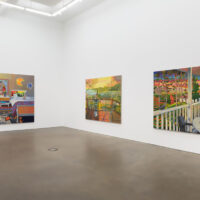Takasago
2017 - Film & Video (Film & Video)
9:20 minutes
Chia-Wei Hsu
The word Takasago alludes to several things at once. Takasago is the name of a multi-billion dollar Japanese corporation, previously situated in Taiwan pre-World War II. It is also a famous Japanese Noh play, the oldest extant form of performance in Japan, combining dance, costuming/masks, acting, and operatic chants. Finally, Takasago was the Japanese name for Taiwan during the Japanese occupation from 1895 until the end of World War II. The video work Takasago by Chia-Wei Hsu departs from these intertwined references by placing a performance of the Noh play Takasago inside of an industrial perfume plant owned by the Takasago corporation, using the play’s theme of a married couple to allegorize the relationship between Japan and Taiwan. The video flows back and forth across the screen, two masked actors portraying the protagonists singing to one another, each in their own frame. The mechanical background against the stripped, pale costuming of the actors creates a hollow, sonorous beauty, at once indicative of industrial relations and deep-set histories between the respective nation states. Through its allegorical use of the characters Takasago formulates a geopolitical relationship of affective embodiment, manifesting national identity in a performative body. This move grapples directly with the experience of historical geography as an individual in the contemporary present, possessing a multitude of influences. That this experience is radically funneled through the ever-changing phenomena of tradition itself allows Takasago to assume an open profundity, using a single traditional form given a variety of meanings, and marking a divergent approach from the rest of his practice. This centralized approach allows Takasago to amalgamate into a cold, beautiful meditation on inter-Asian cultural contact and its relationship to time. It proposes a relationship divergent from the enmity towards Japan that some Taiwanese still feel to this day, loosening the boundaries between national and individual identity in favor of an affective, constellating relation.
Embarking from myriad audio-visual narratives, Chia-Wei Hsu pursues imaginative interrogations of cultural contact and colonization in Asia, oftentimes amalgamating his primary narratives with non-human actors including technologies, animals, gods, environments, traditions, and material objects. Bringing these diverse subjects together results in a bumpy ontological bleed between them, forming the topography of a historical geography without a straightforward objective position. By reinterrogating what histories and relations coexist within a given locale, Hsu’s work manifests new imaginative potentialities for their revitalization, an uncertain, profound terrain throughout his films and installations. While his work has consistently probed regulatory systems including religion, science, architecture, and military action, Hsu’s work has increasingly explored digital ontologies and the Internet of Things, in which previously luddite household objects have become connected to the internet. The digital, as a territorializing field produced by components largely manufactured in Asia, allows Hsu to attempt the detournement of western knowledge-bases to formulate new, imaginative archipelagos.
Colors:
Related works sharing similar palette

© » KADIST
Noé Martínez
2019As he investigates the forms that slavery took through different events that occurred during the sixteenth century in the Huasteca region of Mexico, Noé Martínez tells, in a non-linear narrative, the history of human trafficking in Relación de tráfico de personas 1525-1533 I (Study of Trafficking of Persons 1525–1533 I) ...

© » KADIST
Felix Gmelin
2004Ambiguous Gestures takes as its point of origin a film Gmelin discovered in his father’s archive...

© » KADIST
James "Yaya" Hough
2016This untitled ink and pencil drawing by James “Yaya” Hough is made on what the artist calls “institutional paper”, or the state-issued forms that monitor the daily activities of prisoners, of which, each detainee is generally required to fill out in triplicate...

© » KADIST
Pratchaya Phinthong
2022Pratchaya Phinthong’s work has explored the mineral and karmic economies of Laos, a country that shares language, beliefs, and a long border with his own native region of Isaan (Northeast Thailand)...

© » ARTFORUM
Expo Chicago Announces Participants for 2024 Edition – Artforum Read Next: RUTH FOUNDATION FOR THE ARTS NAMES WINNERS OF INAUGURAL $100,000 RUTH AWARDS Subscribe Search Icon Search Icon Search for: Search Icon Search for: Follow Us facebook twitter instagram youtube Alerts & Newsletters Email address to subscribe to newsletter...

© » KADIST
Araya Rasdjarmrearnsook
2005The Class (2005) by Araya Rasdjarmrearnsook challenges the viewer’s personal sense of morality and tolerance by depicting a classroom from hell...

© » KADIST
Robert Zhao Renhui
2014Created during Zhao Renhui’s residency at Kadist SF in 2014, Zhao Renhui began observing and cataloguing insects inspired by the scientific impulse towards exhaustive taxonomy of Sacramento-based Dr...

© » KADIST
Dale Harding
2018Dale Harding’s installation Body of Objects consists of eleven sculptural works that the artist based on imagery found at sandstone sites across Carnarvon Gorge in Central Queensland...












